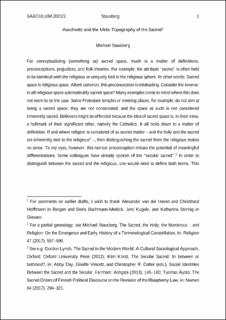| dc.description.abstract | This article proposes a distinction between the religious and the sacred. It treats the sacred as an analytical concept and seeks to demonstrate its effectiveness by using it as a lens through which to look at Mucha’s photograph of the gatehouse at Auschwitz-Birkenau. As an analytical concept, the sacred is disentangled into a series of master tropes: the sacred as the ineffable, the sacred as a binary/oppositional category, the sacred as contagion and transformative ambiguity, the sacred as a liminal category, the sacred as excess of meaning, the sacred as the non-negotiable and inviolable. The article seeks to demonstrate that some of the tropes related to the sacred yield meaningful analysis of this extraordinary space of memory as reflected and mediated through Mucha’s picture. Finally, the article addresses the interplay of the religious and the sacred by looking at religious and political claims, discursive and ritual appropriations referred to here as sanctifications of a sacred space. | en_US |
